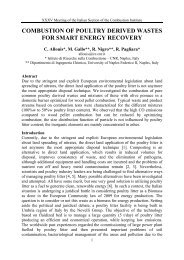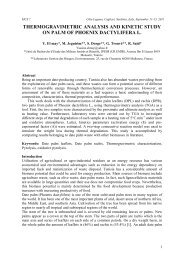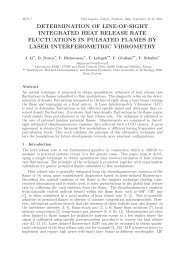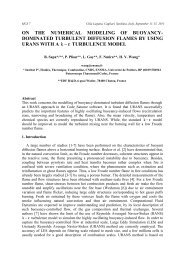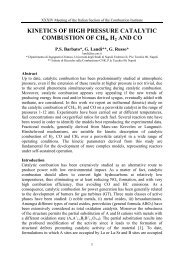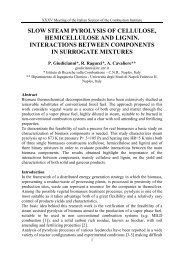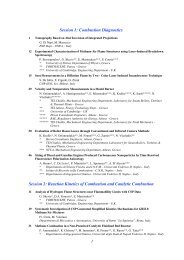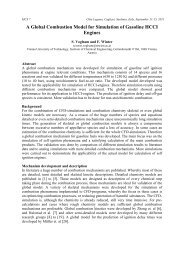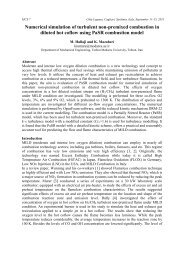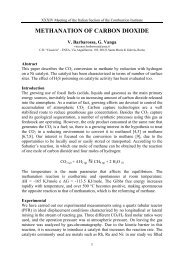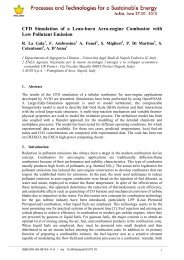seawater so2 scrubbing in a spray tower for marine application
seawater so2 scrubbing in a spray tower for marine application
seawater so2 scrubbing in a spray tower for marine application
You also want an ePaper? Increase the reach of your titles
YUMPU automatically turns print PDFs into web optimized ePapers that Google loves.
XXXV Meet<strong>in</strong>g of the Italian Section of the Combustion Institute<br />
Literature concern<strong>in</strong>g fuel switch <strong>in</strong> ships and possible post-combustion DeSOx<br />
processes <strong>in</strong> the mar<strong>in</strong>e field is very poor despite SWS has been widely discussed<br />
as a future solution <strong>for</strong> ships. In fact, it has been suggested that SWS is an<br />
economically attractive solution, where <strong>scrubb<strong>in</strong>g</strong> per<strong>for</strong>mance relies on <strong>seawater</strong><br />
natural alkal<strong>in</strong>ity [2,3]. The advantages of us<strong>in</strong>g <strong>seawater</strong> <strong>in</strong>volve simple plant<br />
design, no addition of chemicals and no solid by-products. The acidified effluent<br />
can be discharged directly <strong>in</strong>to the sea, after a neutralization step by mix<strong>in</strong>g with<br />
fresh <strong>seawater</strong> and additional <strong>for</strong>ced oxidation of sulfite ions by air blow<strong>in</strong>g.<br />
The use of <strong>seawater</strong> <strong>for</strong> SO2 <strong>scrubb<strong>in</strong>g</strong> has long been recognized as a viable<br />
technology <strong>in</strong> the case of coal power plants. Oikawa et al. [4] describe the technical<br />
and environmental aspects of a <strong>seawater</strong> wet scrubber used as an FGD device <strong>for</strong> a<br />
600 MWe carbon power plant <strong>in</strong> Ch<strong>in</strong>a. Three different boiler load<strong>in</strong>gs were<br />
considered us<strong>in</strong>g a low sulfur content coal, and an SO2 removal efficiency of 95-<br />
98% was achieved <strong>in</strong> a per<strong>for</strong>ated plate scrubber. Similar figures were reported by<br />
Williams [5], who described an experimental test of SWS carried out <strong>in</strong> a low<br />
sulfur coal plant. Chemical and physical features of the <strong>seawater</strong>-SO2 <strong>in</strong>teraction<br />
are described by Sun et al. [6], who focused on a membrane contactor scrubber.<br />
Only few reports are available where SWS was per<strong>for</strong>med on a real work<strong>in</strong>g ship,<br />
and most of these reports come from <strong>in</strong>dustries <strong>in</strong>volved <strong>in</strong> SO2 scrubber<br />
production. An <strong>in</strong>terest<strong>in</strong>g experimental report was issued by BP Mar<strong>in</strong>e [7] on the<br />
desulfurization efficiency of a SWS plant <strong>in</strong>stalled on the “Pride of Kent” ship. The<br />
scrubber was <strong>in</strong>stalled <strong>for</strong> a 1 MW auxiliary eng<strong>in</strong>e, record<strong>in</strong>g a removal efficiency<br />
of nearly 100% correspond<strong>in</strong>g to a 36 m 3 /h water flow. Seawater pH values after<br />
<strong>scrubb<strong>in</strong>g</strong> the exhaust gas from the eng<strong>in</strong>e were also recorded: <strong>seawater</strong> pH at the<br />
scrubber exit resulted to be much lower than at the <strong>in</strong>let, due to the <strong>in</strong>teraction with<br />
the acid gases <strong>in</strong> the exhaust gas. Kircher et al. [8] reported on a monitor<strong>in</strong>g<br />
campaign of a SWS scrubber <strong>in</strong>stalled on a 7.2 MW ship burn<strong>in</strong>g HFO. SO2 and<br />
PM emissions were monitored, and the SO2 removal efficiency was about 75%.<br />
Specific requirements <strong>for</strong> maritime SO2 <strong>scrubb<strong>in</strong>g</strong> systems <strong>in</strong>clude: low energy<br />
consumption and pressure drop, simplicity and adaptability to exist<strong>in</strong>g equipment,<br />
stability and eas<strong>in</strong>ess of control. One possible candidate technology meet<strong>in</strong>g these<br />
requirements is <strong>spray</strong> <strong>scrubb<strong>in</strong>g</strong>, which is known to be an effective technology <strong>for</strong><br />
the desulfurization of fuel oil flue gas [9]. Caiazzo et al. [10] recently presented a<br />
<strong>spray</strong> scrubber model focused on the use of <strong>seawater</strong> under mar<strong>in</strong>e diesel eng<strong>in</strong>e<br />
exhaust conditions. Results showed that natural <strong>seawater</strong> alkal<strong>in</strong>ity and <strong>in</strong>ternal<br />
circulation <strong>in</strong> the droplets assure an enhanced SO2 absorption from the gas-phase.<br />
To comply with the MARPOL limits the amount of <strong>scrubb<strong>in</strong>g</strong> <strong>seawater</strong> was found<br />
to be conspicuous, imply<strong>in</strong>g large dimensions of the <strong>scrubb<strong>in</strong>g</strong> <strong>tower</strong>.<br />
This paper reports on the setup of a <strong>seawater</strong> <strong>spray</strong> scrubber and on the<br />
experimental tests carried out under typical exhaust conditions of a mar<strong>in</strong>e diesel<br />
eng<strong>in</strong>e burn<strong>in</strong>g heavy fuel oil. SO2 capture experiments were carried our us<strong>in</strong>g real<br />
<strong>seawater</strong> picked up at about 1000 m from the Naples coast and distilled water, <strong>for</strong><br />
comparison.<br />
2



